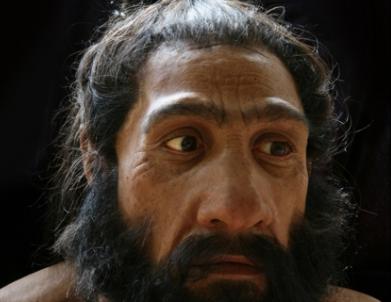There has been much speculation,
research, and debate regarding how human nose size and shape signifies
adaptation to various climates. It is a relatively well-accepted fact that
populations that evolved in warm climates possess large, wide noses with big
openings to aid in cooling the body, while humans in cold climates have evolved
narrow noses that warm and moisten air before it reaches the lungs.
But Neanderthal noses have been
extremely confounding in our understanding of how nose size can respond to
selection pressures from climate. The Neanderthal is widely recognized as its
own extinct hominid group, though it is still debated whether it should be
designated as an extinct form of Homo sapiens or as its own species, Homo neanderthalensis. Despite this debate, clues from the Neanderthal
nose can still be useful indicators of human evolution, since the Neanderthals
is undoubtedly a card-carrying (spear-carrying, perhaps?) member of the Homo classification, owing to its large brain volume and
other characteristics. So, back to the nose: the reason the Neanderthal nose is
so bewildering is that Neanderthals are known to have had wide noses with
extremely large openings. Since they inhabited glacial Europe thousands of
years ago, their large open noses seem contradictory to modern evolutionary
thought. Until recently, it was believed that oversize Neanderthal noses
corresponded to extra-lengthy sinuses, which could actually serve to warm the
cold ambient air before it reached the lungs. However, in 2011 it was proven
that Neanderthal sinuses were comparable in size to our own, indicating that
their large noses must have been more parallel in function to those of modern
humans from tropical regions, whose noses are clearly involved in cooling
functions.
 |
| A Neanderthal nose |
So what can explain the seemingly
incongruous large nose of a cold-dwelling human ancestor? Well, Neanderthals
may not have been such extreme-weather conquerors after all. While the image of
a hairy, fur-clothed, wolly-mammoth-hunting caveman is familiar to all of us,
the nasal peculiarities of Neanderthals suggest more temperate origins. Combine
the large nose, standard-sized-sinuses, and recently discovered
plant-matter-caked-teeth of the Neanderthal, and we have ourselves a species
best adapted to warmer climates. Did the Neanderthal, then, originate in warmer
regions and migrate to the cold? Could their warm weather noses have
contributed to their being maladapted to freezing temperatures, and thus played
a part in their demise during the last European Ice Age ? With the confounding
Neanderthal noses explained, the pattern of climate-adapted facial features in
modern humans remains clear, and nose size can generally be tied to region of
origin. But with the liberal use of climate control and the extreme population
mixing that characterize our modern world, who knows what the nose knows
anymore!
-Hannah
Sources:
picture:http://brendans-island.com/blogsource/20101015ff/NeanderthalNose.jpg
Gray, Richard. "Neanderthals Were Not Ugly Because of the Cold, New Research Finds." The Telegraph, 16 Jan. 2011. Web. 14 Mar. 2012. <http://www.telegraph.co.uk/science/science-news/8261609/Neanderthals-were-not-ugly-because-of-the-cold-new-research-finds.html>.
Laitman, Jeffrey T., Joy S. Reidenberg, Samuel Marquez, and Patrcik J. Gannon. "What the Nose Knows: New Understanding of Neanderthal Upper Respiratory Specializations." Proceedings of the National Academy of Sciences 93.20 (1996).JSTOR. Web. 14 Mar. 2012.
Russell, Mark. "Unlocking the Mystery of Neanderthals' Big Nose." Newser. 17 Jan. 2011. Web. 14 Mar. 2012. <http://www.newser.com/story/109870/unlocking-the-mystery-of-neanderthals-big-nose.html>.
Posting again on Eric's because that's just where we did our group blog from. Anyway.
ReplyDeleteAmazing how one feature could have such an impact on the survival (or death) of a population! This also raises questions about why they might have migrated in the first place. Interesting read!
-Mindy MacKay
This was really interesting! I hadn't thought of large noses contributing to extinction before. Initially, I thought that even though it's not helping them, that it wouldn't hurt their survival. But I suppose larger noses would be be more likely to suffer frostbite which could cause infection. Very interesting to think about.
ReplyDeletelame
ReplyDelete